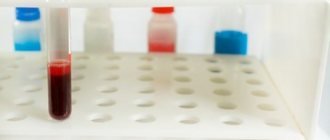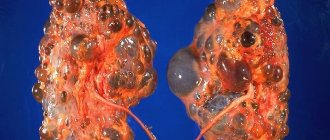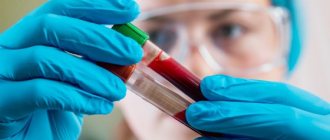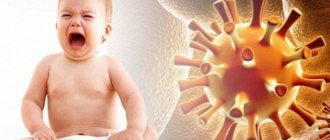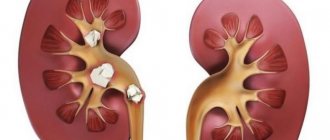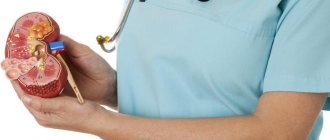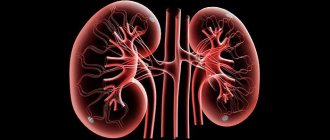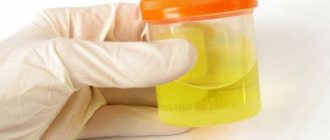Common causes of concentration drops
Reduced creatinine levels are relatively rare and are called hypocreatinemia. This symptom indicates the presence of certain problems with protein metabolism, either throughout the body or in a specific tissue area. Kidney disorders do not have a significant effect on creatinine; the essence of the problem lies not in their work, but in the depletion of protein reserves accumulated by tissues.
A decrease in the content of the metabolite in question is not in itself a disease and does not always require urgent measures. Creatinine can be influenced by many different factors, the set of which, moreover, may be different for women and the stronger sex.
But there are some common reasons:
- following low-protein diets, including vegan/vegetarian;
- fasting treatment;
- exhaustion caused by chronic diseases;
- reduction in muscle mass and volume, which is often observed in people with a sedentary lifestyle;
- long-term treatment with glucocorticosteroids used in the treatment of rheumatism and allergic reactions;
- final stages of cancer pathologies;
- swelling;
- dehydration and the resulting deficiency of antidiuretic hormone;
- infectious lesions accompanied by impaired blood flow in the kidneys.
Other reasons include prolonged adherence to bed rest during the recovery period from illnesses and injuries. Not only physical influences have a lowering effect, but also stress, shock, emotional and psychological stress.
Norms for women
The level of the substance depends on many factors: the gender of the patient, age, kidney condition and general health of the person.
When determining standard indicators, doctors are guided by the following figures:
- for girls under one month of age, the content ranges from 18 to 88 µmol of metabolite per liter of blood;
- from a month to one year – from 18 to 35 µmol;
- from one to 12 years – within 27-62 µmol;
- in teenage girls 12-17 years old - from 44 to 88 µmol;
- from 17 and further – in the range from 58 to 96 µmol;
- elderly women 60 and older – from 53 to 106 µmol.
The exact reasons that cause a drop in creatinine in women are difficult to determine.
Among the influencing factors:
- Lack of body weight.
- Taking glucocorticosteroids.
- Strict diets.
- Pregnancy.
A slight decrease in creatinine (up to a level of 35-70 µmol) during pregnancy is completely normal. This is due, first of all, to the fact that the expectant mother’s body is forced to work “for two,” the total volume of blood increases, and the load on the internal organs, including the kidneys, increases.
Symptoms
There are no specific manifestations of deficiency of this enzyme - they are directly related to changes in the health status of the human body. That is why, when changing the indicators of an important metabolic product, practitioners take into account whether the patient has:
- signs of intestinal dysfunction - indigestion, dyspepsia;
- feelings of heaviness and pain in the right hypochondrium;
- loss of strength of unknown etiology;
- reduction in vigorous activity;
- visible weight loss;
- previous injuries;
- excessive psycho-emotional stress;
- painful sensations in the heart.
The patient needs to undergo additional diagnostic tests, and based on their results, adequate treatment measures are prescribed.
How to increase creatinine and maintain it at normal levels?
To normalize low levels of the substance, the expectant mother must adhere to a number of rules and recommendations:
- You can't go on strict diets. Nutrition should be balanced and healthy.
- A woman should get a good night's sleep and rest fully, going to bed on time.
- To maintain muscle and overall tone, you should either do simple exercises or take regular walks. An important component of therapy is maintaining muscle mass, and even gradually increasing it.
- If there are no objections from the attending physician, you can take a course of vitamin preparations.
The diet should include protein-rich foods to compensate for the lack of protein in the body:
Low creatinine - causes
Low concentration of creatinine in the blood (hypocreatinemia) is a very rare phenomenon. This is a sign of problems with protein metabolism throughout the body or only in one muscle tissue.
Renal dysfunction does not have a particular effect on the concentration of this metabolite in the blood. The problem here is different: the body’s protein resources accumulated in the muscles are depleted.
New Year's video recipe
:
Low creatinine in itself is not a disease and does not need to be treated. There are many factors that reduce its concentration, and they can be different for men and women. Here are the common reasons for its decrease for both sexes:
- “rational” malnutrition due to low-protein plant-based vegetarian or vegan diets;
- therapeutic fasting;
- pathological exhaustion (cachexia) caused by chronic diseases of internal organs;
- decrease in muscle mass due to insufficient physical activity;
- the occurrence of muscle atrophy with old age;
- long-term glucocorticosteroid pharmacotherapy, which doctors prescribe for allergies and rheumatism;
- thermal (final) stage of cancer;
- edematous phenomena;
- dehydration (severe dehydration);
- lack of antidiuretic hormone due to dehydration;
- severe infectious diseases, which are often accompanied by serious problems with the blood supply to the kidneys.
The cause of hypocreatinemia can also be long-term bed rest due to severe diseases of the cardiovascular system (stroke, myocardial infarction, acute heart failure) or immobilization caused by bone fractures and paralysis of the limbs.
The psychological factor also plays a role. Thus, creatinine in the blood decreases during shock, severe stress and psychological trauma.
Uric acid
Uric acid is a special marker in assessing the state of purine metabolism. With a satisfactory clinical history of a woman, a simultaneous increase in UA in the blood and urine is usually caused by dietary habits: fatty meat, offal, spices, smoked foods, sugar, alcoholic beverages, especially beer.
Creatinine levels also differ according to a woman’s age.
Pathology is also observed in women with diseases of the cardiovascular system after long-term treatment with drugs from the group of cytostatics. Urea increases in renal failure. The higher the urea, the lower the glomerular filtration rate. High urea indicates end-stage renal failure.
A persistent increase in uric acid provokes the development of gout or gouty arthritis. Normal levels of sUA in women’s blood are 2.5–8 mmol/l.
Causes of low creatinine specific to a particular gender
The female body differs from the male body in the presence of estrogens, a more fragile constitution, and slower absorption of proteins. In addition, women are usually less active than men and do less hard work. Therefore, their blood creatinine is lower more often. Specific factors that lead to this include:
- First trimester (first three months) of pregnancy. It happens that it decreases in the second trimester.
- Severe cases of anorexia, when a woman loses more than 30% of her normal body weight.
In men, low creatinine is less common than in women, which is due to better muscle development, faster absorption of proteins, the presence of the male hormone testosterone, and most importantly, greater physical activity. Typically, creatinine in men falls due to:
- chronic severe liver diseases (cirrhosis, hepatitis, atrophic processes);
- problems with blood flow in the liver;
- problems with blood supply to the kidneys;
- obstruction of the urinary canal (stones, neoplasms);
- Duchenne and Becker diseases, which cause muscular dystrophy. These diseases are usually not caused by lifestyle or poor environment and are transmitted exclusively by inheritance.
Factors of influence
When interpreting analyses, it is important to consider the following influencing factors:
- pregnancy and lactation;
- lifestyle and physical activity;
- quality of food and diet;
- age, height, weight of the woman;
- presence of bad habits;
- drug therapy.
Against the background of a favorable medical history, creatinine levels vary for physiological reasons and are easily corrected. With age, creatinine usually decreases in women, which is due to natural aging of the body and a decrease in muscle tone.
How to increase
It is not difficult to increase the concentration of creatinine in the blood. To do this you just need:
- increase physical activity to build muscles, but at the same time try not to overexert the body;
- maintain a sleep schedule - sleep at least 7 hours, try not to go to bed too late;
- change your diet: eat more foods rich in protein. These include fish, meat, milk, pasta, nuts and rice;
- drink more water (at least 1.5 liters per day);
- take vitamin and mineral complexes to compensate for protein deficiency.
When should you get tested for creatinine?
Doctors refer for this test if the patient has:
- arterial hypertension;
- renal failure;
- sepsis (blood poisoning);
- states of shock.
This test should be given to patients before undergoing dialysis (blood purification for kidney failure) and taking kidney samples.
All patients admitted to the intensive care unit also have their creatinine levels checked.
Before submitting you need:
- Do not physically overstrain your body for several days;
- limit your intake of protein foods, eat a maximum of 200 grams of meat or fish products the day before the test;
- do not drink coffee and alcohol;
- drink enough water (at least one and a half liters per day).
A low level of creatinine in the blood can either mean nothing or be a harbinger and sign of serious illness. It is up to the doctor to establish the reasons for its decrease. If it is not caused by diseases, then returning the normal level of this metabolite in the blood is not at all difficult. You need to exercise more, get enough sleep, eat well and your creatinine will be fine again.
Creatinine is a substance formed as a result of chemical reactions during the metabolism of proteins and amino acids in the body. It enters the blood and is excreted from the body through the kidneys. Translated from scientific language, this means that creatinine can serve as an indicator of kidney activity (increased) or depletion of the body’s energy reserves (decreased). During pregnancy, creatinine is usually low, especially in the first months. This is a consequence of the large consumption of reserves for the formation of new life. Reduced creatinine in general, and in particular during pregnancy, is not an indicator of the disease. With equal success, long-term starvation, exhaustion, and grueling diets lead to this situation. Low creatinine levels do not need to be treated with medications.
Diagnostic value
In general, a creatinine test can reflect the functional state of the excretory system and kidneys, in particular in a pregnant woman. Obstetric practice shows that this indicator tends to decrease during pregnancy; this is regarded as the norm. A particularly pronounced decrease in the by-product of creatine metabolism is observed in the initial period of physiological gestation.
This is explained by the following compensatory reactions of the pregnant woman’s body in response to the active development of the fetus:
- The volume of circulating blood in a pregnant woman increases several times, which increases the filtration load on the kidneys. In this case, the urine receives a pronounced dilution, which reduces the percentage of all biochemical indicators.
- Many protein substrates enter the body of the growing fetus, which needs them as the basis for the full development and formation of all structures and organs. Creatine, as an energy substrate for maternal muscle work, is used in reduced quantities. Therefore, pregnant women quickly get tired and have a hard time withstanding physical activity, and a growing feeling of fatigue is an indirect sign of an “interesting situation.”
Source of energy for your muscles
Chemical reactions are constantly taking place in the body, and the lion's share of them takes place in the muscles. It is during these metabolic reactions that creatinine is formed. It then enters the bloodstream and is excreted from there in the urine, passing through the kidneys. If you find out how much creatinine is in the blood, you can assess the load on the kidneys and draw a conclusion about their condition.
During pregnancy, low creatinine levels are normal due to the woman’s condition.
Muscle contraction is the most energy-intensive process, so they contain powerful natural energy carriers that work as backup generators in critical situations. The main source of energy is creatine, one of the nonessential amino acids, synthesized in the liver and then sent to muscle tissue. During the breakdown of the amino acid, energy is released and creatinine is formed - a breakdown product that no longer takes part in any chemical processes, and therefore is no longer needed by the body, and must be eliminated.
The level of creatinine in the blood is a relatively constant value. It largely depends on the size of a person’s muscle mass (not to be confused with total body weight). Therefore, the normal rate for men will be higher than for the fairer sex. Muscle volume cannot change instantly, which is why creatinine levels are so useful for assessing kidney function.
Creatinine is a slag, a waste product, it must be eliminated from the body as soon as possible. It is not too toxic, in itself it is not dangerous to health (within reasonable limits), but sharp jumps in its content in the blood indicate the danger of some kind of disease. This usually refers to the most common failure - high creatinine.
We recommend that you find out how cranberries are beneficial in the diet of pregnant women.
ALT, AST and amylase indicators
The contraction of individual groups of the muscle frame occurs almost every second, which cannot but be reflected in the laboratory determination of creatinine. The immediate source of energy in the form of ATP (adenosine triphosphoric acid) molecules is consumed by the muscles after dephosphorylation of a special form of creatine - a replaceable protein monomer. A by-product of this process is creatinine, which is excreted by the kidneys.
The final metabolite of the breakdown of phosphorylated creatine is not used by the body for other needs. Moreover, creatinine when circulating in the bloodstream can have toxic effects.
Creatinine metabolism can fail at any stage:
- with excessive consumption of amino acids and protein foods;
- at the stage of natural energy formation, which is associated with insufficient enzyme activity;
- with functional kidney failure, which does not fully cope with the excretion of creatinine.
However, the physiological norm reflects the fact that creatinine is not excreted by the kidneys in absolute quantities. Any contraction of living muscle is accompanied by the consumption of ATP, and consequently the formation of a by-product. The immediate cleansing of creatinine from the blood is accompanied by a new supply of this product.
The concentration of creatinine in the blood also depends on the woman’s age, the characteristics of her activity and diet.
Considering that creatinine is involved in many metabolic processes in the body, fluctuations in test results lead to changes in other biochemical criteria.
Biochemical criteria characterize the functioning of the liver, kidneys, and muscle tissue. Both indicators must be assessed together:
- AST, or AST (aspartate aminotransferase) is a special enzyme that converts the aspartic amino acid. The highest concentrations are found in the myocardium, muscles, liver, and kidneys. AST is located inside tissue cells, therefore, with any damage to the cell membrane, this criterion is found in the blood in high concentrations. Normal for women
Relationship between creatinine levels and pregnancy
In women who are not pregnant, low creatinine is rare; this condition is normal during pregnancy. It means that the body of the expectant mother begins to use up protein reserves accumulated in the muscles. As protein levels decrease, the creatinine level in the blood also decreases.
Important: in contrast to the increased indicator, a slight decrease in creatinine in pregnant women, especially in the 1st-2nd trimesters, is a completely normal condition.
The normal amount of creatinine is described by a range of values. So, for women the norm is from 44 to 80 µmol/l (micromoles per liter). This variation is explained by differences in lifestyle, level of physical activity, body composition, differences in age and hormonal balance.
Why does “blood nitrogen” change in pregnant women?
The decrease in the amount of nitrogenous substances in the blood of pregnant women is due to the fact that the processes of protein synthesis (the formation of new fetal tissues) exceed the rate of its breakdown. In addition, in the case of creatinine, its formation is highly dependent on physical activity and muscle work. During the normal daily routine of a pregnant woman, her muscle work is at a lower level, which explains the decrease in the level of this blood indicator in pregnant women.
An increase in urea and creatinine levels often occurs simultaneously (doctors in this case talk about increased blood nitrogen or azotemia). In pregnant women, this is often caused by kidney damage due to gestosis and eclampsia. Also, the cause of this condition may be an incorrect diet of a pregnant woman (consuming large amounts of protein foods), glomerulonephritis, urolithiasis, tumors of the kidneys and urinary tract.
In addition, in a number of conditions, an individual increase in creatinine levels is possible - the amount of urea remains normal or increases very slightly. This phenomenon is accompanied by a number of endocrine pathologies - diabetes mellitus, increased activity of the thyroid gland (hyperthyroidism) and pituitary gland (acromegaly). A lot of creatinine enters the blood during the breakdown of muscle tissue, so its increase can be caused by massive injuries or muscular dystrophies.
Various types of kidney damage often become a complication during pregnancy - long-standing chronic diseases can become aggravated and worsened, or new ones can arise. This poses a threat to the health of the expectant mother and child, so doctors closely monitor the amount of nitrogen in the blood - urea and creatinine.
How to maintain normal creatinine during pregnancy
To normalize creatinine levels, the expectant mother should:
- adhere to the principles of healthy eating (no diets!);
- get a good night's sleep, go to bed as early as possible - the healthiest sleep is in the middle of the night;
- Do light exercise or take long walks (this will keep your muscles toned);
- on the recommendation of a doctor (!), you can take vitamins to normalize protein metabolism.
The expectant mother bears an increased burden and double responsibility. As a result, the woman’s physical and mental state is unstable. Hence stress, nervousness, tearfulness. Unfortunately, this negativity also affects the child’s health. In addition, severe stress, shock or psychological trauma, which are already dangerous during pregnancy, can also cause low creatinine levels in the blood.
Caring for a child begins from the moment of pregnancy and continues throughout life. Take care of your health, avoid worries and heavy stress, because by doing so you are protecting your unborn baby. Do not hesitate to ask your loved ones for help or seek advice from a specialist. Any person needs a timely spoken word or support, but an expectant mother simply needs it!
